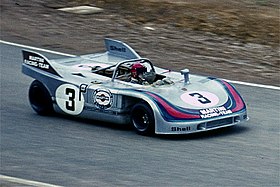
Back Porsche 908 German پورشه ۹۰۸ Persian Porsche 908 French Porsche 908 Italian ポルシェ・908 Japanese Porsche 908 Dutch Porsche 908 NB Porsche 908 Polish Porsche 908 Russian Porsche 908 Swedish
This article needs additional citations for verification. (April 2018) |
You can help expand this article with text translated from the corresponding article in German. (June 2018) Click [show] for important translation instructions.
|
| Porsche 908 | |
|---|---|
 Porsche 908/3 of 1971 | |
| Overview | |
| Manufacturer | Porsche |
| Production | 1968–1971 |
| Designer | Helmuth Bott (chassis) Hans Mezger (engine) |
| Body and chassis | |
| Class | 1966-1971: Group 6 prototype-sports car 1972-1975: Group 5 sports car 1976-81: Group 6 two-seater racing car |
| Body style | Coupé spyder |
| Layout | RMR |
| Powertrain | |
| Engine | 3.0 L flat 8 (908/01, 02, 03) 2.1 L turbocharged flat 6 (908/03) |
| Dimensions | |
| Length | 4,839 mm (190.5 in) |
| Curb weight | 650 kg (1,430 lb) |
| Chronology | |
| Predecessor | Porsche 907 |
| Successor | Porsche 936 |
The Porsche 908 was a racing car from Porsche, introduced in 1968 to continue the Porsche 906-Porsche 910-Porsche 907 series of models designed by Helmuth Bott (chassis) and Hans Mezger (engine) under the leadership of racing chief Ferdinand Piëch.
As the FIA had announced rule changes for Group 6 prototype-sports cars limiting engine displacement to 3,000 cc, as in Formula One, Porsche designed the 908 as the first Porsche sports car to have an engine with the maximum size allowed. The previous Porsche 907 only had a 2,200 cc Type 771/1 flat-eight engine developing 270 PS (199 kW). The new 3-litre Type 908 flat-eight produced 350 PS (257 kW) at 8,400 rpm. Being traditionally air-cooled and with only two valves per cylinder, it still had less power compared to more modern F1 designs which delivered over 400 hp (300 kW), but were not suited to endurance racing.
The 908 originally was a closed coupe to provide low drag at fast tracks, but from 1969 on was mainly raced as the 908/2, a lighter open spyder. A more compact 908/3 was introduced in 1970 to complement the heavy Porsche 917 on twisty tracks that favored nimble cars, like Targa Florio and Nürburgring. Sold off to privateers for 1972, various 908s were entered until the early 1980s, often retro-fitted with Porsche 934-based 2.1-litre turbocharged flat-six engines.